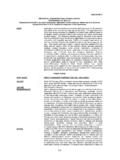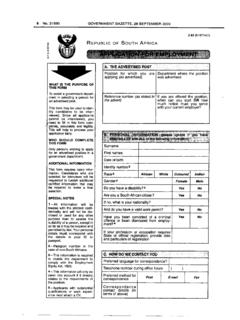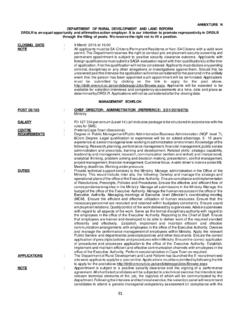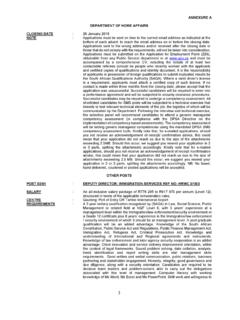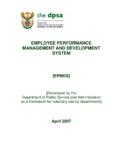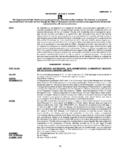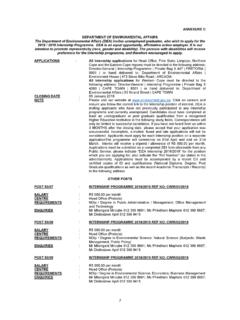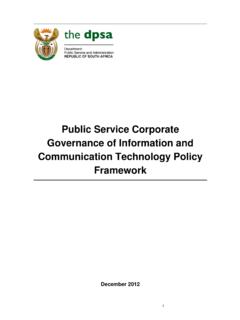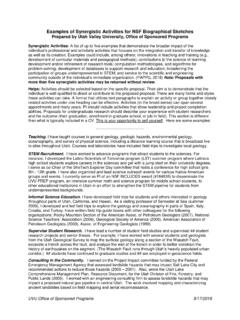Transcription of TOOLKIT ON STANDARD OPERATING PROCEDURES
1 Page 1 of 13 TOOLKIT ON STANDARD OPERATING PROCEDURES Page 2 of 13 Contents 1. Background .. 3 2. Why the TOOLKIT .. 3 3. Benefits of SOPS .. 4 4. Definition of SOPS .. 4 5. Approaches to SOPs .. 4 6. Step by Step Guidance .. 5 Step 1: Determine Objective of SOP .. 5 Step 2: Appoint a SOP 5 Step 3: Produce a SOP .. 6 Name the SOP .. 6 Determine the scope of SOP .. 6 Chart the procedure .. 7 Date when the SOP became operative .. 7 Periodicity of the review .. 7 The signature and name of the person authorising the 8 Step 4: Distribute and File SOP .. 8 7. SOPS Step by Step Diagram .. 9 8. Training on SOPs .. 10 9. Non-Conformance .. 10 10. Conclusion .. 10 STANDARD Operational Procedure Elements.
2 11 SOP Formats and Templates .. 11 EXAMPLE 1 .. 12 EXAMPLE 2 .. 13 Page 3 of 13 1. Background A STANDARD OPERATING procedure (SOP) is a set of written instructions that document a routine or recurring activity followed by an organisation. The development and use of SOPs are a fundamental part of a successful quality system as it makes available information to employees to perform a job effectively and efficiently. A SOP facilitates consistency in the quality and integrity of an end product or end result. Clear and effective SOPs are essential in the development and deployment of any solution. The Service Delivery Organization Transformation (SDOT) framework was developed to provide direction and guidance on the development, implementation, monitoring, report and feedback on the SDOT interventions in the public service.
3 Fundamentals in this regard include among others; the macro-organisation of the public service, service delivery mechanisms, norms and standards to access quality services for all, enhanced citizen engagement and participation and the promotion of innovative learning and knowledge management. One of the key principles underpinning SDOT framework is promoting the agenda of a developmental state by institutionalizing quality service through effective and efficient SDOT mechanism. Central to this is the development of the service delivery planning and implementation value chain that include framework and TOOLKIT stipulating the minimum required norms and standards for business process mapping, review and management, STANDARD OPERATING PROCEDURES , setting of service standards.
4 The development of a framework and methodology for developing effective SOPs were finalised in March 2011 as a result of a need for consistency and a set STANDARD . 2. Why the TOOLKIT The TOOLKIT is intended to assist Departments in developing and implementing and maintaining SOPs. Every Department needs to prepare a comprehensive set of SOPs to provide structure to important administrative functions. Each Department will need to tailor information to their unique needs and preferences. The TOOLKIT on SOP will serve as an important guide to assist Departments to improve communication. SOPs help integrate departmental operations, linking the work of managers and planners with the activities of other workers.
5 SOPs act as effective communication tools that contribute to worker understanding and job satisfaction. STANDARD OPERATING PROCEDURES include steps that outline when and how information should flow between departments. The SOP development process, while demanding, can provide significant performance improvements. When properly and fully carried out, the development process brings workers, managers, and advisers together in a collaborative way. As a result, everyone focuses their abilities on doing the best job possible with the department s resources. The knowledge of SOPs will make departments understand processes in order to improve efficacy in achieving government s outcomes.
6 Page 4 of 13 3. Benefits of SOPS The development and use of SOPs minimizes variation and promotes quality through the consistent implementation of a process or procedure within a department. The benefits of SOPs are outlined as follows: Standardisation of activities SOPs identify planned and agreed upon roles and actions. This information helps standardize activities and promote co-ordination and communication among personnel. SOPs thus help to assure the quality and consistency of a service; Explanation of performance expectations SOPs describe and document what is expected of personnel in the performance of their official duties.
7 As such they provide a benchmark for personnel, an objective mechanism for evaluating operational performance, and a tool for promoting a positive organisational culture. It ensures that good practice is achieved at all times; Training and reference document Written SOPs can provide a framework for training programmes and briefings. These activities in turn improve the understanding of work requirements and helps identify potential problems. A comprehensive SOP manual also serves as a reference document for personnel and SOPs provide a contribution to the audit process 4. Definition of SOPS A SOP is a specific procedure or set of PROCEDURES established to be followed in carrying out a given operation or in a given situation to enhance quality through following a standardized work procedure.
8 SOPs are part of a continuous improvement strategy which should be continuously reviewed and revised as services become more efficient. 5. Approaches to SOPs SOPs should be written in a concise step by step easy to read format. The information provided should be unambiguous and not overly complicated. The active voice and present verb should be used. Using the active voice is preferred as it results in fewer words, it is more engaging to readers, and it comes across as direct and concise. The document should not be wordy, redundant or overly lengthy. Keep it simple and short. Information should be conveyed clearly and explicitly to remove any doubts as to what is required The organisation should have a procedure in place for determining what PROCEDURES or processes need to be documented.
9 Several categories and types of SOPs can be distinguished. A number of important SOP types are: Fundamental SOPs These give instructions how to make SOPs of the other categories. Methodic SOPs these describe a complete testing system or method of investigation SOPs for safety PROCEDURES Page 5 of 13 SOPs for OPERATING instruments and other equipment SOPs for analytical methods SOPs for the preparations of reagents SOPs for receiving and registration of samples SOPs for Quality Assurance SOPs for Archiving and how to deal with Complains The initiative and further procedure for the preparation, implementation and management of documents is a procedure in itself which should be described.
10 These SOPs should at least mention: Who can and who should make which type of SOP To whom the proposal for a SOP should be submitted and who adjudges the draft The procedure of approval Who decided on the date of implementation and who should be informed. How revisions can be made or how a SOP can be withdrawn. 6. Step by Step Guidance There are four main steps in developing a SOP: Step 1: Determine Objective of SOP The author of a SOP should be very clear on its objectives while writing it. They can be broadly described as follows: Define the expected results of implementation, regulatory or organisational; Understand why a SOP is needed and who will use it and how will it be used; Determine the SOP needs and assign local responsibility for management and review; Distinguish between SOPs, guidelines, policy statements and work instructions and learn how each may work for area of responsibility in a concerted, integrated way; Implement appropriate SOP training programmes; and Implement review and control system.
